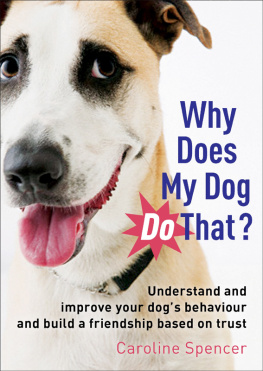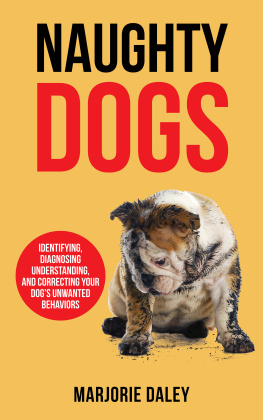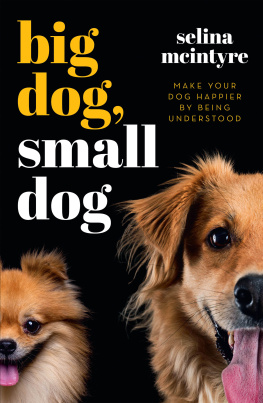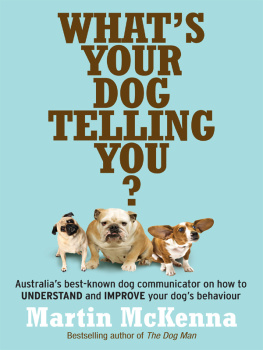Caroline Spencer has thirty years experience of training and working with dogs. She is the owner of Pure Dog Listeners Ltd and offers seminars and dog-owner consultations, teaching canine communication methods to correct undesirable behaviour in dogs. She is also joint inventor of the Happy At Heel harness for all dog walking problems.
Find out more at www.puredoglisteners.com

Other titles from How To Books
Canine Cuisine
Elaine Everest
Showing Your Dog
Elaine Everest
A New Puppy in the Family
Elaine Everest
The New Puppy Owners Manual
Angela Fitch
Why Does My Dog Do That?
Caroline Spencer

Constable & Robinson Ltd
55-56 Russell Square
London WC1B 4HP
www.constablerobinson.com
First published in the UK by How To Books,
an imprint of Constable & Robinson Ltd., 2013
Copyright Caroline Spencer 2013
Cartoons Colin Shelbourn 2013
www.shelbourn.com
The right of Caroline Spencer to be identified as the author of this work has been asserted by her in accordance with the Copyright, Designs & Patents Act 1988
All rights reserved. This book is sold subject to the condition that it shall not, by way of trade or otherwise, be lent, re-sold, hired out or otherwise circulated in any form of binding or cover other than that in which it is published and without a similar condition including this condition being imposed on the subsequent purchaser.
A copy of the British Library Cataloguing in Publication
Data is available from the British Library
ISBN 978-1-8452-8510-4 (paperback)
ISBN 978-1-4721-1006-0 (ebook)
Printed and bound in the UK
1 3 5 7 9 10 8 6 4 2
Cover design: Bob Eames
Acknowledgements
Thanks to all the dogs I have known and loved who continue to teach me so much.
Thanks also to Lesley Harris APDL for her endless patience she listened, she read and she commented and helped make valid points readable and understandable.
Thank you also to Nikki and Giles at How To Books; Jo Stansall at Constable & Robinson; and Jon Davies.
Finally, thank you to Paul Manktelow for writing the foreword to this book.
Contents
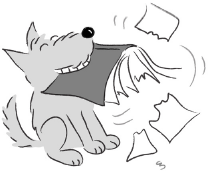
On-lead Pulling
Preface
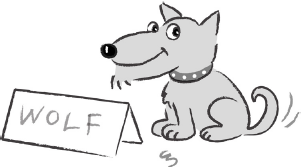
Our modern-day dogs ancestor is the wolf they share almost identical DNA so present many similar behaviours. However, our domestic dogs have evolved to live with humans and, because of this, now show many different behaviours compared with their wild cousins. With this in mind, the behaviour of wild wolves is not the focus of our attention here, but it has an important part to play in our learning. If we just looked to wolves, it would be like studying chimps in order to make sense of humans. They have their similarities but also their differences, so it is very useful to look at both for an understanding of how the communication works as well as behaviours, and therefore logical to look to wolves to gain some insight regarding their communication and how they work as a team.
Its interesting to speculate as to how wolves eventually evolved into what we now know as dogs. The human race began domesticating wolves thousands of years ago. Recent studies in Russia have revealed how this was probably done. They used the silver fox, an animal famed for its aggressive temperament, and picked the calmer and more placid pups. Within three generations, they found they were producing foxes that were able to interact with humans. Even more amazing was the fact that not only had they produced a gentler personality but that physical changes were happening, too, both in colour and general appearance some animals having floppy ears, for instance. This almost certainly happened with the wolf as the brighter ones realised that there was a food source available if they hung around human settlements. Both sides of the partnership benefited: the wolves through food, and the humans by early warning and protection and, subsequently, by working together when hunting. As the changes in the wolves colours and body shape occurred naturally, we humans would no doubt have hurried things along by encouraging the changes we liked.
As a result, vastly different looks appeared, culminating in the huge variety of domestic dogs we have today. So, in essence, we have different looks and kinder (as perceived by humans) personalities, but the brain make-up and communication skills remain the same.
Within our human family, we have to set boundaries. It is the same within a pack of dogs and, remember, the term pack is a word devised by humans to describe a family of dogs or wolves, as pride describes a family of lions. Within all these families, if there were no rules, boundaries, guidance or understanding then the group would not function adequately and therefore their survival would be compromised. We need to understand the domestic dog to understand fully their communication skills, their social behaviours and hierarchy. But similarly, they need to understand us as well it is a two-way street.
Domestic dogs have the capacity to understand us to a certain extent more so even than chimps, which are thought to be our closest relatives but we must be aware that within each breed and litter there are many personalities just as there are in the human family. This is what we work with individual personalities. As with teaching anyone, how easily the student will learn depends largely on personality and intelligence. If the dog thinks the teacher is not up to the job, then learning will be limited.
We must clearly understand that a dog can only be a dog and a human a human; we both have to find a mutually acceptable level of understanding to enable the dog to adapt to the behaviours that we hope to see demonstrated.
In order to build the best possible relationship between dog and human, it is essential to avoid cruel behaviours and gadgets. Collars and leads are used because the law requires us to, but it is preferential to use a harness, particularly when working with a dog that has been abused and is spooked by restrictions around the back of the neck or around the throat. All you need are a lead, collar or Happy At Heel Harness (designed and patented by us), some toys, food rewards, kindness, consistency and imagination.
Its not what you say, its what you do... and its not only what you do, its what you feel. It all starts within you. So if your dog just isnt getting it, look at your own behaviour first dont blame your dog.
The principles of PURE dog listening are nothing new; it is the language of the canine. Other people have written their take on communicating in such a way and so I thought now it was my turn. I have spent a considerable amount of time dog watching, reading and testing my theories and those of others, principally in the area of guiding and bringing up your dog without resorting to command training or bribing or using intimidating body language or vocals. Books written by John Fisher, Desmond Morris and Turid Rugaas were a huge inspiration early on. I have watched hundreds of people over the years with their dogs and children, working out why some were great and relaxed, some like cats on hot bricks, others completely oblivious to their owners while others were all over them like a rash. It was the owners that caught my imagination, and the more I spoke and asked them what they did, the more it dawned on me that less is more. Dont bug, dont bribe, dont intimidate just guide in a gentle and consistent manner that they understand. When a dog is doing something naughty, its because it doesnt get it.
Next page
